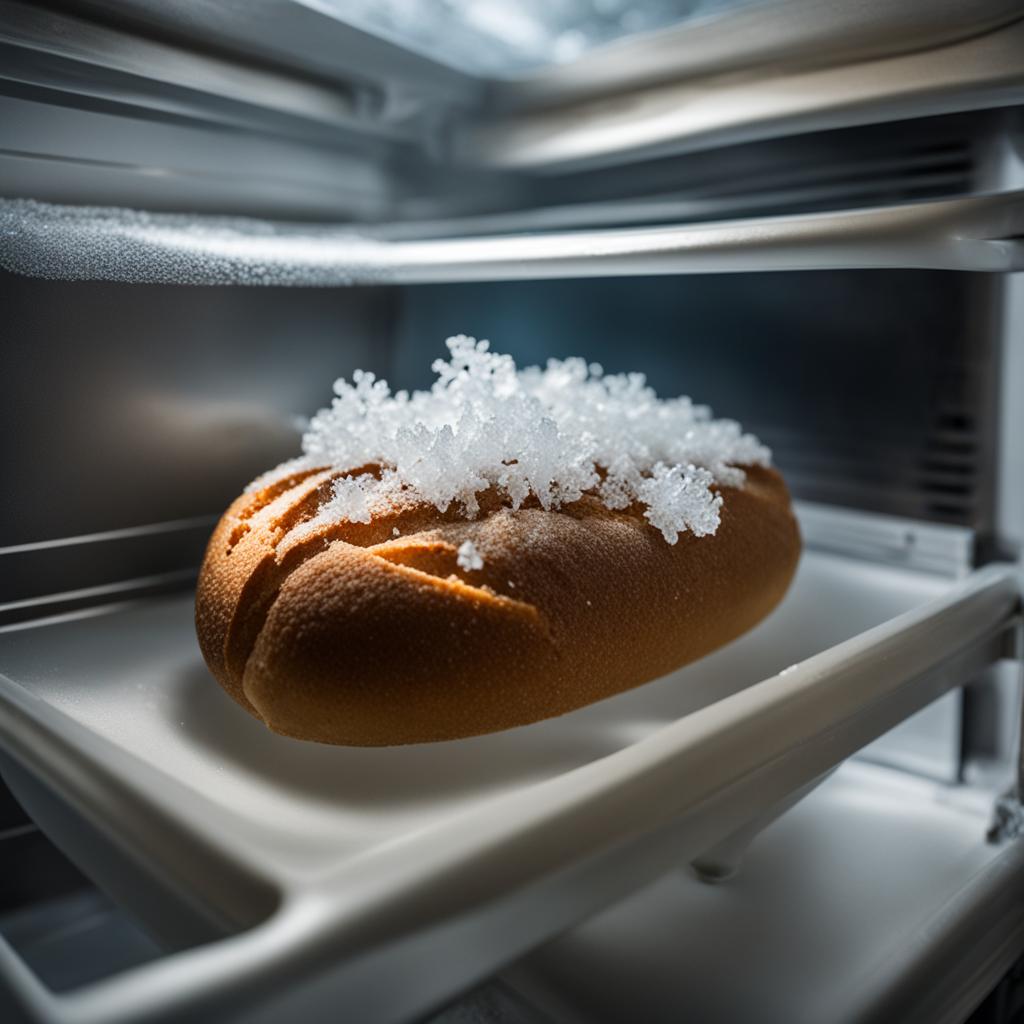When it comes to bread storage, many people wonder how long bread can last in the fridge. The truth is, refrigeration may not be the best option for storing bread. Let’s find out why.
Storing bread in the fridge can cause it to become dry and lose its moisture. The cold temperatures of the refrigerator can lead to the recrystallization of starch in the bread, resulting in a tough and stale texture. To keep your bread fresh and delicious, it’s best to store it at room temperature.
So, where should you store your bread? The ideal place is a cool, dark, and dry spot such as a pantry, breadbox, or cabinet. By storing your bread at room temperature, you can maintain its optimal freshness for longer.
Key Takeaways:
- Storing bread in the fridge can cause it to become dry and lose its moisture.
- Refrigeration can lead to the recrystallization of starch, resulting in tough and stale bread.
- The best place to store bread is at room temperature in a cool, dark, and dry spot like a pantry or breadbox.
- Freezing bread can help extend its shelf life.
- If your bread becomes stale, you can repurpose it in various recipes, such as bread pudding or homemade breadcrumbs.
The Effect of Refrigeration on Bread
When it comes to bread storage, refrigeration is a common method that many people use. However, refrigerating bread can have a negative impact on its taste and texture. Let’s take a closer look at how refrigeration affects bread and why it may not be the best option.
One of the main issues with storing bread in the fridge is starch recrystallization. The cold temperatures cause the starch in the bread to reorganize, resulting in a dry and tough texture. This can make the bread taste stale and less enjoyable to eat. Additionally, the fridge can also cause the bread to lose moisture, further contributing to its deterioration in both taste and texture.
It’s important to note that while refrigeration can help extend the shelf life of bread, it may not be worth sacrificing the quality and freshness. Instead, it is recommended to store bread at room temperature in a cool, dark, and dry place such as a pantry or breadbox. This allows the bread to maintain its moisture and stay soft and flavorful for a longer period.
By understanding the effects of refrigeration on bread, you can make informed decisions about how to store your bread to ensure optimal freshness and taste. The next section will explore the best places to store bread and provide practical tips for prolonging its shelf life.
Table: The Effects of Refrigeration on Bread
| Effect | Impact on Bread |
|---|---|
| Starch Recrystallization | Dry and tough texture, stale flavor |
| Loss of Moisture | Deterioration in taste and texture |
| Extended Shelf Life | May help prolong freshness, but compromises quality |
The Best Place to Store Bread
When it comes to bread storage, finding the right place is essential for maintaining its freshness and quality. Storing bread at room temperature is the ideal option, as it allows the bread to stay moist and delicious for longer periods. Here are some great options for storing your bread:
Pantry:
One of the most common places to store bread is in the pantry. Make sure to keep it in a cool, dry area away from direct sunlight or heat sources. A bread bin or a breadbox can be a great addition to your pantry, as it provides an additional layer of protection against moisture and exposure to air.
Cabinet:
If you don’t have a dedicated pantry, storing bread in a cabinet can also work well. Choose a cabinet in a part of your kitchen that doesn’t get too hot or too dry. Similar to the pantry, it’s essential to keep the bread away from direct sunlight and heat sources.
Original Packaging or Plastic Wrap:
Whether you choose to store your bread in the pantry or cabinet, it’s crucial to keep it in its original packaging or wrap it tightly in plastic wrap. This helps to retain its moisture and prevent it from drying out. Remember to seal the packaging or plastic wrap properly to maintain its freshness.
By following these storage tips and keeping your bread at room temperature in the pantry, cabinet, or breadbox, you can enjoy fresh and delicious bread for longer periods. Avoid refrigerating your bread, as it can lead to dryness and loss of moisture. Instead, create an optimal environment for your bread by storing it in a cool, dark, and dry place.
| Storage Option | Benefits | Considerations |
|---|---|---|
| Pantry | – Cool, dry environment – Protection from sunlight and heat – Additional storage space with a bread bin or breadbox |
– Ensure proper sealing to prevent exposure to air – Check for any signs of mold or spoilage |
| Cabinet | – Convenient storage option – Keeps bread in a suitable temperature range – Easy access in the kitchen |
– Choose a cabinet away from heat sources – Keep bread away from direct sunlight |
| Original Packaging or Plastic Wrap | – Maintains moisture and freshness – Prevents bread from drying out – Easy to seal and store |
– Ensure proper wrapping to avoid air exposure – Store in a cool and dark place |
By taking proper care of your bread and storing it in the best place at room temperature, you can enjoy fresh, flavorful slices whenever you want. Remember to consume homemade bread within three to five days, and commercially-prepared bread within five to seven days, for the best taste and texture. With these storage tips, your bread will stay delicious for longer!
Freezing Bread for Extended Shelf Life
When it comes to extending the shelf life of bread, freezing is a great option. Freezing bread helps to preserve its freshness and allows you to enjoy it for longer periods. Here are some helpful tips for freezing bread:
- Wrap the bread tightly: Before freezing, make sure to wrap the bread tightly in plastic wrap to prevent freezer burn and to keep out moisture. This will help maintain its quality and taste.
- Remove excess air: When wrapping the bread, try to remove as much air as possible from the packaging. This will help prevent the bread from getting freezer burn and keep it fresh.
- Consider portioning: If you prefer to have smaller portions of bread, consider slicing the loaf before freezing. This way, you can easily thaw and use only the amount you need without having to defrost the entire loaf.
- Label and date: To keep track of the freezing time, label the packaged bread with the date you froze it. This will help you know how long it has been in the freezer and when it should be used.
By following these freezing tips, you can prolong the shelf life of your bread and have it readily available whenever you need it. Whether you want to stock up on your favorite bread or save leftovers, freezing is a convenient way to preserve bread for later use.
Repurposing Stale Bread
If you find yourself with stale bread that has lost its freshness, don’t despair! Stale bread can still be put to good use in various recipes, allowing you to minimize food waste and create delicious dishes.
One popular way to utilize stale bread is by making bread pudding. This comforting dessert is made by soaking stale bread in a mixture of milk, eggs, sugar, and your choice of flavorings such as cinnamon or vanilla. The bread absorbs the liquid, resulting in a moist and custard-like texture. Top it off with a drizzle of caramel sauce or a sprinkle of powdered sugar for a truly indulgent treat.
Another great way to repurpose stale bread is by turning it into homemade breadcrumbs. Simply tear or cut the bread into small pieces and pulse them in a food processor until you achieve the desired texture. You can then use these breadcrumbs to add a crispy coating to baked chicken or fish, sprinkle them on top of casseroles for added crunch, or even use them as a topping for macaroni and cheese.
Recipes using stale bread:
- Bread Pudding with Caramel Sauce
- Crispy Baked Chicken with Homemade Bread Crumbs
- Macaroni and Cheese with Breadcrumb Topping
If you prefer savory options, stale bread can also be transformed into delicious croutons. Simply cut the bread into small cubes, toss them with olive oil, herbs, and seasonings of your choice, and bake them in the oven until golden and crispy. These homemade croutons are perfect for adding a flavorful crunch to salads or for floating on top of a bowl of creamy tomato soup.
So, the next time you have stale bread sitting on your countertop, don’t throw it away. Get creative in the kitchen and turn it into something delicious!
Why Not to Store Bread in the Fridge

When it comes to bread storage, it’s important to understand why refrigeration may not be the best option. Storing bread in the fridge can expedite the staling process and reduce the bread’s freshness. The cold temperatures of the refrigerator can cause the starch in the bread to recrystallize, resulting in dry and tough bread with a stale flavor. Additionally, the fridge can cause the bread to lose moisture, further contributing to its deterioration in taste and texture.
The staling process of bread is accelerated in the fridge due to the cool and moist environment. The cold temperatures cause the bread to lose moisture, leading to a dry and less enjoyable eating experience. When bread loses moisture, it becomes harder and more crumbly, making it difficult to enjoy in sandwiches or toast. The recrystallization of starch also changes the bread’s texture, making it tough and less pleasant to eat.
To maintain the freshness of bread, it is best to store it at room temperature in a part of the kitchen that is not too hot or dry. Keeping it in a pantry, breadbox, or cabinet will help preserve its quality and extend its shelf life. By storing bread correctly, you can enjoy its softness, flavor, and texture for a longer period of time.
The Ideal Storage for Fresh Bread
When it comes to storing fresh bread, the ideal environment is at room temperature in a cool and dry part of your kitchen. Placing your bread on the kitchen counter is a great option that allows for proper air circulation while keeping it easily accessible for daily consumption.
It’s important to avoid storing bread in areas that are exposed to direct sunlight. Sunlight can cause the bread to heat up and become dry, which can affect its quality and freshness. Instead, choose a spot away from windows or any other sources of direct sunlight.
By storing your bread at room temperature, you’ll be able to maintain its optimal texture and taste. Fresh bread is best enjoyed within two to three days of purchase, so be sure to consume it before it starts to stale. If you find that you won’t be able to finish the loaf within that time frame, consider freezing it for longer shelf life.
Overall, the key to preserving the freshness of your bread is to store it in a cool, dark, and dry environment. By following these storage tips, you can ensure that your bread stays delicious and enjoyable for as long as possible.
Freezing Bread for Longevity
When it comes to preserving bread for an extended period, freezing is an excellent option. Freezing bread not only helps maintain its freshness but also allows you to enjoy it at a later time. To freeze bread effectively, follow these simple steps:
- Wrap the bread tightly in a freezer bag to prevent freezer burn and moisture loss.
- If you prefer, you can slice the bread before freezing for easier portioning.
- Consider using wax paper between the slices to prevent them from sticking together.
- Make sure to label the freezer bag with the date to keep track of its freshness.
When you’re ready to enjoy the frozen bread, there are a couple of ways to defrost it. The most recommended method is to thaw the bread overnight in the refrigerator. This gradual thawing process helps prevent sogginess and ensures the bread retains its moisture.
If you’re in a hurry, you can also reheat frozen bread directly. Preheat your oven to 350°F (175°C) and place the frozen bread on a baking sheet. Bake for about 10 minutes or until the bread is heated through and crispy on the outside. Alternatively, you can use a toaster to quickly thaw and warm individual slices.
Freezing Bread Dos and Don’ts:
- Do wrap the bread tightly in a freezer bag to prevent freezer burn and maintain freshness.
- Do label the freezer bag with the date to keep track of its storage time.
- Do consider slicing the bread before freezing for easier portioning.
- Don’t freeze bread that is already stale or past its prime, as freezing will not restore its freshness.
- Don’t refreeze bread that has been previously thawed, as it can affect the texture and taste.
By following these tips, you can ensure that your bread stays fresh and delicious even when stored in the freezer. Whether you’re saving a loaf for later use or have some leftover slices, freezing bread is a convenient and practical solution to extend its shelf life.

Utilizing Stale Bread in Recipes
When bread becomes stale and loses its freshness, there’s no need to toss it out. Stale bread can still be put to good use in various delicious recipes, making it a versatile ingredient in the kitchen.
For bread that is two days old, when it is still relatively firm and crusty, consider using it in recipes like bread pudding or panzanella. The texture of the bread provides a perfect base for soaking up flavors, whether it’s a sweet bread pudding with cinnamon and raisins or a savory panzanella salad with tomatoes, cucumbers, and herbs.
By day three, when the bread is hard to the touch, it can be transformed into croutons or breadcrumbs. Croutons are a fantastic addition to salads, soups, and even as a crunchy topping for casseroles. Simply cut the stale bread into cubes, toss them in olive oil, season with herbs and spices, and bake until golden and crispy. Alternatively, you can turn the stale bread into breadcrumbs by pulsing it in a food processor until you achieve the desired consistency. These breadcrumbs can be used in various recipes, such as breading for chicken or as a topping for macaroni and cheese.
Stale Bread Recipe Ideas:
- Bread Pudding with Cinnamon and Raisins
- Panzanella Salad with Tomatoes, Cucumbers, and Herbs
- Homemade Croutons for Salads and Soups
- Breaded Chicken or Fish
- Breadcrumb Topping for Macaroni and Cheese
Quote:
“Don’t let stale bread go to waste! Get creative in the kitchen and transform it into delicious dishes that the whole family will love.”
So the next time you have stale bread on hand, don’t despair. Instead, get creative in the kitchen and discover the many ways you can utilize stale bread in recipes. Whether it’s bread pudding, croutons, or breadcrumbs, there’s always a way to turn stale bread into a tasty and satisfying meal.
Storage Tips from a Head Baker
As a former head baker, I’ve learned a thing or two about preserving the freshness of bread. When it comes to storage, freezing is the key. To keep your bread at its best, wrap it tightly in a freezer bag. You can freeze the whole loaf or slice it and separate the slices with wax paper for convenient portioning later.
For those who prefer to keep their bread at room temperature, a paper bag is your best friend. Storing a fresh loaf in a paper bag on the counter helps maintain its freshness by allowing air circulation. Avoid using plastic bags as they tend to trap moisture and can promote mold growth.
If you’re looking for a stylish and functional storage option, consider investing in a bread box. Look for one with small holes for air circulation, as it keeps the bread fresh without exposing it to excess moisture. A bread box also adds a touch of charm to your kitchen countertop.
FAQ
How long does bread last in the fridge?
Storing bread in the fridge may cause it to become dry and lose its moisture. It is best to store bread at room temperature for optimal freshness.
What happens to bread when stored in the refrigerator?
Refrigeration can cause the starch in bread to recrystallize, resulting in dry and tough bread with a stale flavor. The cold temperatures also cause the bread to lose moisture, further deteriorating its taste and texture.
Where is the best place to store bread?
Bread should be stored at room temperature in a cool, dark, and dry place such as a pantry, breadbox, or cabinet.
Can you freeze bread?
Yes, freezing bread can help extend its shelf life. It is recommended to wrap the bread tightly in plastic wrap and aluminum foil to prevent freezer burn.
What can I do with stale bread?
Stale bread can be used to make delicious bread pudding or homemade breadcrumbs. It can also be transformed into croutons for salads and soups.
Why is storing bread in the fridge not recommended?
Storing bread in the fridge can expedite the staling process and reduce its freshness due to the cold temperature and environment.
Where is the ideal place to store fresh bread?
Fresh bread is best stored at room temperature in a cool and dry part of the kitchen. Avoid areas exposed to sunlight.
How should I freeze bread for longevity?
Wrap the bread tightly in a freezer bag, either whole or sliced, and defrost in the refrigerator overnight for best results.
What can I do with stale bread in recipes?
Stale bread can be used for various purposes, such as bread pudding, homemade breadcrumbs, or croutons for salads and soups.
What storage tips do bakers recommend?
Bakers suggest freezing bread for freshness, storing fresh bread in a paper bag on the counter, or using bread boxes with small holes for air circulation.
Source Links
- https://www.southernliving.com/food/bread/should-bread-be-refrigerated
- https://www.realsimple.com/food-recipes/shopping-storing/food/bread-storage
- https://www.foodandwine.com/cooking-techniques/storing-bread-tips
Related Recipes:
 How to Store Parsley? (Perfect Every Time!)
How to Store Parsley? (Perfect Every Time!)
 How to Store Carrots? (Perfect Every Time!)
How to Store Carrots? (Perfect Every Time!)
 Beef Stew Shelf Life: How Long Does It Last in the Fridge?
Beef Stew Shelf Life: How Long Does It Last in the Fridge?
 Can You Freeze Stuffing? How to Preserve the Holiday Dish
Can You Freeze Stuffing? How to Preserve the Holiday Dish
 How to Freeze Bananas? (Perfect Step-By-Step Guide)
How to Freeze Bananas? (Perfect Step-By-Step Guide)
 Does Peanut Butter Go Bad? Shelf Life and Storage Tips
Does Peanut Butter Go Bad? Shelf Life and Storage Tips
 Does Garlic Powder Go Bad? How to Store Properly.
Does Garlic Powder Go Bad? How to Store Properly.
 Can You Freeze Garlic? Here’s How to Do It Right.
Can You Freeze Garlic? Here’s How to Do It Right.








